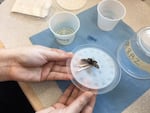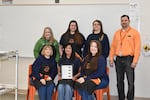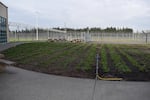Inside Oregon’s only women’s prison, Coffee Creek Correctional Facility, a butterfly conservation lab is helping to recover a rare Northwest species of butterfly. Women incarcerated there make up the team of butterfly technicians and lab assistants powering the conservation work.

An adult Taylor's checkerspot butterfly being fed in Coffee Creek's butterfly conservation lab.
Courtesy of the Oregon Department of Corrections
The Taylor's checkerspot butterfly, native to the Pacific Northwest, has lost 99% of its original prairie habitat, with only two remaining populations in the state of Oregon. That's according to conservationists at the Oregon Zoo, which advises the program at Coffee Creek. Taylor's checkerspots are federally listed as an endangered species.
The Taylor’s checkerspot program at Coffee Creek was launched in 2017, modeled after similar programs in correctional facilities in Washington. It’s a collaboration between the women’s prison, the Oregon Zoo, the U.S. Department of Fish and Wildlife, and the Institute for Applied Ecology. Since the program’s inception, the lab has raised over 1,200 larvae for release as caterpillars back into the wild.

The Coffee Creek butterfly conservation lab team, along with Ronda Naseth of the Oregon Zoo and Chad Naugle of the Oregon Department of Corrections. Carolyn Exum is pictured on the bottom left.
Courtesy of the Oregon Department of Corrections
Carolyn Exum is one of the lab’s five butterfly technicians. She’s incarcerated at Coffee Creek on a felony murder charge.
Speaking to OPB’s “Weekend Edition” from inside the prison, Exum said she worked with animals before during her incarceration at Coffee Creek. In one program, she was a veterinary assistant. In another, she’s helping to raise a puppy who will grow up to be a service dog.
Exum added, “I’ve always been a person that liked to conserve.” So, when the butterfly lab opened up, working there seemed like a natural fit.
Exum and her colleagues in the lab are working with their third group of Taylor’s checkerspot larvae. Their work begins when biologists with the U.S. Department of Fish and Wildlife bring adult female butterflies they’ve captured in the wild into the prison. This year’s butterflies arrived in May. The butterflies are placed onto plants, and soon lay eggs, which are then collected by lab technicians. This is one of Exum’s favorite parts of the job, she said.
“When the butterflies lay their eggs, we actually have to cut the eggs off the leaves … it’s a fun process to actually watch that up close. And we’re actually been able to catch that on camera,” Exum said.
From there, lab technicians nurture the larvae for months. Exum explained that the larvae go into what’s called the “diapause” stage in midsummer.
“It’s like hibernation for a bear, where they sleep about half the year,” she said.
This year, larvae went into diapause in July. As of August, they’re in warm diapause. “In our lab right now, all of them are tucked into paper towel beds in deli cups on racks while they are sleeping,” Exum said.
In October, they’ll go into cold diapause. During that stage, they’ll be kept in a shed outside on the prison grounds, under terra cotta pots. The caterpillars will wake up in February, which Exum said is the lab’s busiest time.
“We bring them into the lab, and they start to eat. And as you heard about the children’s book 'The Hungry, Hungry Caterpillar' — that’s what they do,” Exum said.

Plantago plants, food for Taylor's checkerspot caterpillars, grown in the yard at Coffee Creek Correctional Facility.
Courtesy of the Oregon Department of Corrections
The Taylor’s checkerspot caterpillars eat a particular type of plant called plantago, which is grown on site just outside the lab. “We have a whole crew of girls that work with our plantago plants out in our fields,” Exum said.
Eventually, the caterpillars are given back to the U.S. Department of Fish and Wildlife to be released back into one of their two remaining habitats in the state. Earlier this year, as part of the lab’s last group of Taylor’s checkerspots, more than 700 caterpillars were released into the wild.
While Exum and her colleagues don’t get to see the site themselves, they get reports and photos of the caterpillars being released. “What we know is that we’re reaching our end goal, which is to repopulate the population back in, so whether we get to actually see it or not, we know that we’re a part of it.”
Meanwhile, day-to-day work in the lab provides a positive outlet for the women employed there.
“It feels like I’m in an actual lab. We work professionally, together … it just takes you out of the actual prison environment, it gives you a sense of peace,” Exum said.
Working in the lab also provides skills that can serve as job qualifications upon a woman’s release from prison. Exum said that she’s learned plenty of skills that she didn’t have prior to her incarceration: data gathering and record keeping, training newer lab assistants, and gaining specialized knowledge about working with the environment. Not to mention teamwork, another of Exum’s favorite parts of the job.
“It’s really nice to have teammates that have the same goal, and to work together with that team,” she said.
When Exum goes back into the community — she’s eligible for release in 2024 — she said she plans to give presentations about Coffee Creek’s programs, including their Taylor’s checkerspot conservation lab, to other correctional facilities in the nation.
For now, she’ll continue her conservation work, knowing the impact she’s having from within the prison’s walls.
“I often say when I’m going to work that we’re saving the earth one butterfly at a time. And I feel like I’m part of a bigger picture. It starts here.”
